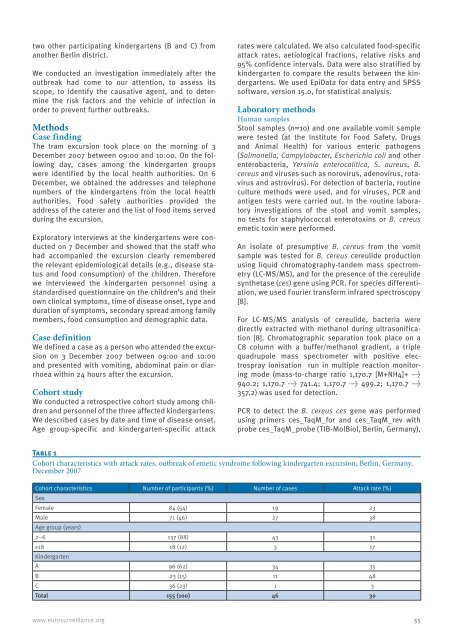Escherichia coli - Eurosurveillance
Escherichia coli - Eurosurveillance
Escherichia coli - Eurosurveillance
Create successful ePaper yourself
Turn your PDF publications into a flip-book with our unique Google optimized e-Paper software.
two other participating kindergartens (B and C) from<br />
another Berlin district.<br />
We conducted an investigation immediately after the<br />
outbreak had come to our attention, to assess its<br />
scope, to identify the causative agent, and to determine<br />
the risk factors and the vehicle of infection in<br />
order to prevent further outbreaks.<br />
Methods<br />
Case finding<br />
The tram excursion took place on the morning of 3<br />
December 2007 between 09:00 and 10:00. On the following<br />
day, cases among the kindergarten groups<br />
were identified by the local health authorities. On 6<br />
December, we obtained the addresses and telephone<br />
numbers of the kindergartens from the local health<br />
authorities. Food safety authorities provided the<br />
address of the caterer and the list of food items served<br />
during the excursion.<br />
Exploratory interviews at the kindergartens were conducted<br />
on 7 December and showed that the staff who<br />
had accompanied the excursion clearly remembered<br />
the relevant epidemiological details (e.g., disease status<br />
and food consumption) of the children. Therefore<br />
we interviewed the kindergarten personnel using a<br />
standardised questionnaire on the children’s and their<br />
own clinical symptoms, time of disease onset, type and<br />
duration of symptoms, secondary spread among family<br />
members, food consumption and demographic data.<br />
Case definition<br />
We defined a case as a person who attended the excursion<br />
on 3 December 2007 between 09:00 and 10:00<br />
and presented with vomiting, abdominal pain or diarrhoea<br />
within 24 hours after the excursion.<br />
Cohort study<br />
We conducted a retrospective cohort study among children<br />
and personnel of the three affected kindergartens.<br />
We described cases by date and time of disease onset.<br />
Age group-specific and kindergarten-specific attack<br />
www.eurosurveillance.org<br />
rates were calculated. We also calculated food-specific<br />
attack rates, aetiological fractions, relative risks and<br />
95% confidence intervals. Data were also stratified by<br />
kindergarten to compare the results between the kindergartens.<br />
We used EpiData for data entry and SPSS<br />
software, version 15.0, for statistical analysis.<br />
Laboratory methods<br />
Human samples<br />
Stool samples (n=10) and one available vomit sample<br />
were tested (at the Institute for Food Safety, Drugs<br />
and Animal Health) for various enteric pathogens<br />
(Salmonella, Campylobacter, <strong>Escherichia</strong> <strong>coli</strong> and other<br />
enterobacteria, Yersinia entero<strong>coli</strong>tica, S. aureus, B.<br />
cereus and viruses such as norovirus, adenovirus, rotavirus<br />
and astrovirus). For detection of bacteria, routine<br />
culture methods were used, and for viruses, PCR and<br />
antigen tests were carried out. In the routine laboratory<br />
investigations of the stool and vomit samples,<br />
no tests for staphylococcal enterotoxins or B. cereus<br />
emetic toxin were performed.<br />
An isolate of presumptive B. cereus from the vomit<br />
sample was tested for B. cereus cereulide production<br />
using liquid chromatography-tandem mass spectrometry<br />
(LC-MS/MS), and for the presence of the cereulide<br />
synthetase (ces) gene using PCR. For species differentiation,<br />
we used Fourier transform infrared spectroscopy<br />
[8].<br />
For LC-MS/MS analysis of cereulide, bacteria were<br />
directly extracted with methanol during ultrasonification<br />
[8]. Chromatographic separation took place on a<br />
C8 column with a buffer/methanol gradient, a triple<br />
quadrupole mass spectrometer with positive electrospray<br />
ionisation run in multiple reaction monitoring<br />
mode (mass-to-charge ratio 1,170.7 [M+NH4]+ →<br />
940.2; 1,170.7 → 741.4; 1,170.7 → 499.2; 1,170.7 →<br />
357.2) was used for detection.<br />
PCR to detect the B. cereus ces gene was performed<br />
using primers ces_TaqM_for and ces_TaqM_rev with<br />
probe ces_TaqM_probe (TIB-MolBiol, Berlin, Germany),<br />
Table 1<br />
Cohort characteristics with attack rates, outbreak of emetic syndrome following kindergarten excursion, Berlin, Germany,<br />
December 2007<br />
Cohort characteristics<br />
Sex<br />
Number of participants (%) Number of cases Attack rate (%)<br />
Female 84 (54) 19 23<br />
Male<br />
Age group (years)<br />
71 (46) 27 38<br />
2–6 137 (88) 43 31<br />
≥18<br />
Kindergarten<br />
18 (12) 3 17<br />
A 96 (62) 34 35<br />
B 23 (15) 11 48<br />
C 36 (23) 1 3<br />
Total 155 (100) 46 30<br />
55

















